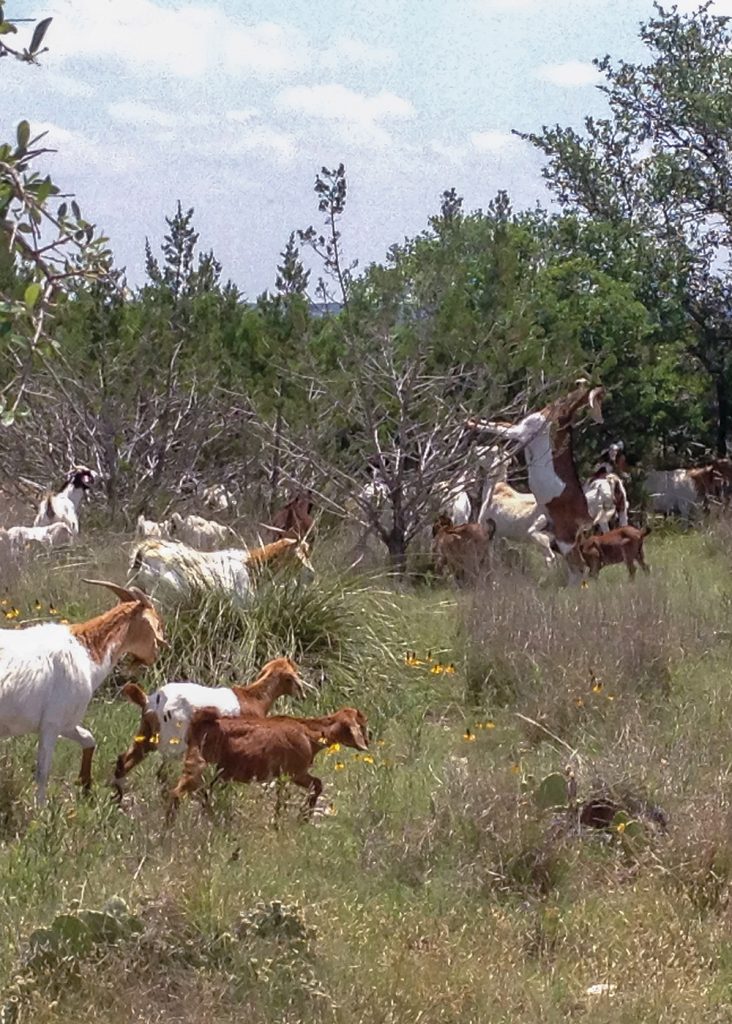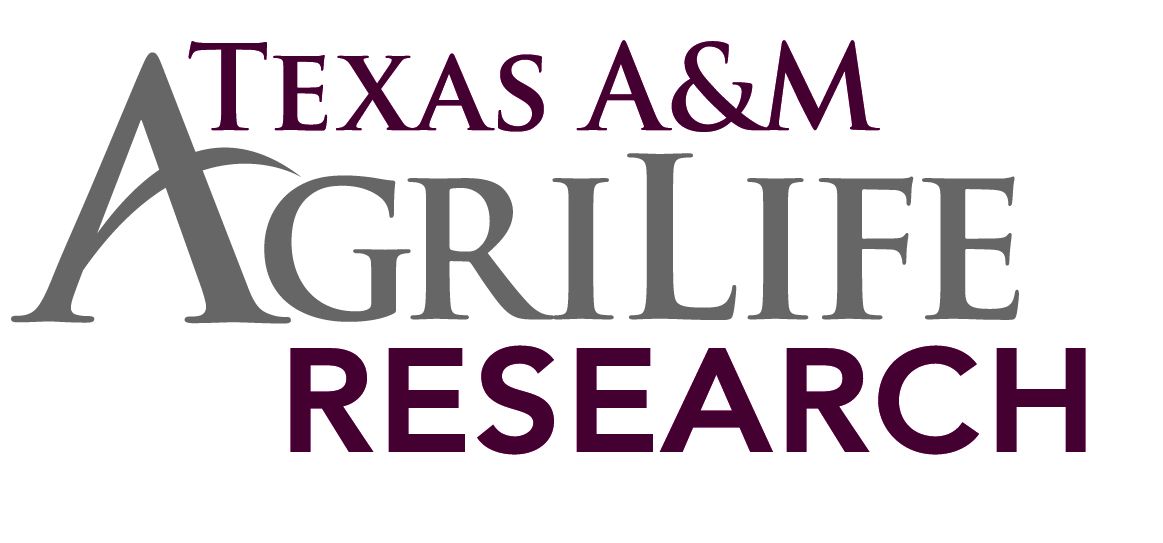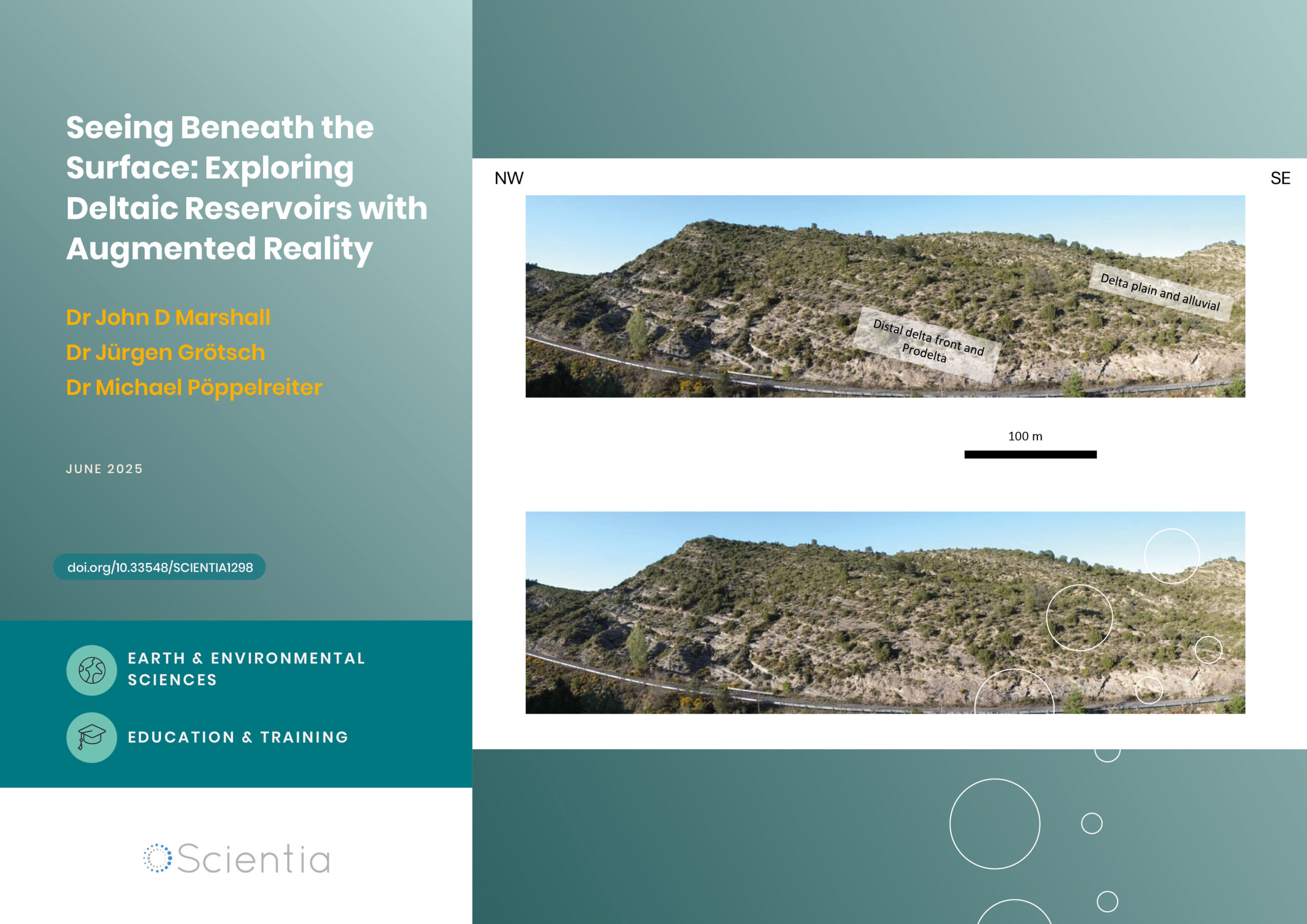Dr John Walker – Herbivore Helpers: Using Livestock to Manage Rangelands
Domestic herbivores – such as cattle, sheep, and goats – are remarkably important to ecosystems. Their feeding behaviours aid the management of natural habitats by preventing any individual plant species dominating the landscape. Thus, understanding livestock dietary preferences is vital for informing land management decisions. Dr John Walker from the Texas A&M AgriLife Research and Extension Center has devoted his career to exploring livestock dietary preferences, and how they can be manipulated to benefit rangelands. His ‘Aggie Cedar Eater’ (ACE) goats are now helping to control invasive juniper shrubs across the Great Plains of the US.
The Importance of Herbivory
When carnivores roamed the lands freely – and in places where they still do – herbivore populations determined the predator population size. In turn, predators kept the number of herbivores down, and thereby prevented overgrazing.
The disruption of this delicate balance – through the loss or exclusion of wild herbivores and predators from many areas – has had consequences for ecosystem function that scientists are only beginning to understand. For example, in the absence of sufficient fire and browsing herbivores, grasslands are susceptible to being taken over by woody plant species. However, human activities can also help to maintain or restore ecosystem function.
Grazing livestock can replace the ecological role of wild herbivores in managing vegetation and maintaining the landscape. In the US, herbivory on ‘rangelands’ – grasslands, shrublands, woodlands, deserts, and wetlands grazed by livestock – is vital to maintaining these landscapes. However, over-grazing can also lead to the loss of individual plant species.
Just like humans, animals have dietary preferences. It is well recognised that livestock grazing affects the composition of rangeland plant communities. By selectively feeding on particularly palatable plants, livestock give unpalatable plant species the opportunity to outcompete the grazed species.
For decades, researchers have been exploring how to manage grazing on rangelands effectively, both to increase livestock productivity and to improve environmental outcomes. A key aim is to target the effects of selective feeding on rangeland habitats. Dr John Walker, a rangeland expert and Professor at Texas A&M AgriLife Research and Extension Center in Texas, has spent more than three decades investigating dietary preferences in livestock, and how they can be influenced to achieve management goals. His overarching goal has been to improve livestock productivity while enhancing the role of livestock grazing to improve rangeland health.
Through some innovative thinking and dedication, Dr Walker has successfully demonstrated how selective breeding can be used to develop livestock that have dietary preferences for specific plants. His ‘ACE goats’ are helping to control the invasive juniper shrub on grasslands across Texas and the surrounding states.
In the US, juniper is a shrub that grows quickly, spreads fast, and outcompetes native plants. It is especially damaging to grassland ecosystems, where it routinely replaces grass species and changes the landscape. By 2013, there were 50 million acres of juniper in Texas alone – an area larger than the entire state of Nebraska – and the plant has been recorded in all 50 states.
Currently, Dr Walker is contributing his considerable expertise – and his juniper-loving goats – to a new collaborative project between rangeland scientists across multiple states, investigating how controlled fires and herbivory can be used to effectively manage rangelands. ‘Effective use of any type of biological control requires an understanding of the grazing behaviour of herbivores and the ecology of the target plant species,’ Dr Walker explains.

Investigating Dietary Preferences
Determining the dietary preferences of livestock is tricky. After all, you can’t ask a cow what they like to eat. Understanding what livestock have been eating, which plants they prefer, and how their feeding behaviours can be influenced are fundamental first steps for developing techniques that support effective rangeland management.
Some methods for determining diet selection are more effective than others. Analysing collected faecal samples is simple, repeatable, inexpensive and useful for both wild and domestic animals. The advanced technologies available to analyse faecal composition each has its own limitations.
They also developed a technique to calibrate and validate a method for determining faecal plant components. The method, called ‘near-infrared spectroscopy’, uses light to accurately assess the botanical composition of samples. The results demonstrated that the method is most accurate when calibrated with samples from the same conditions, for example, a single group of sheep grazing in the same field at the same time. The digestibility of consumed plants and the interactions between dietary components during digestion complicate the task of maintaining the same condition. However, for the right research projects, near-infrared spectroscopy can be a valuable tool.

Manipulating Livestock Dietary Preferences
In some of his earliest research, Dr Walker investigated whether selective feeding could be controlled by managing grazing patterns. Confining and moving livestock between smaller sections of land gives plants the opportunity to recover between grazing. This allows higher stocking densities to be maintained, increases livestock productivity, and has numerous ecological benefits. However, Dr Walker and his colleagues discovered that animals do not become less selective when you control where they graze. For example, sheep will avoid eating leafy spurge even when they are running out of other food plants.
Undeterred, Dr Walker turned his attention to the root causes of dietary preferences. His epiphany came in the form of a blue heeler dog called Gaucho. ‘One day I happened to read an article that described how to teach a heeler to head cattle, which I thought would be a very useful ability. So, I trained Gaucho to do an outrun as good as any border collie,’ explains Dr Walker. ‘Unfortunately, when I tried to use this new skill on cattle, Gaucho reverted to instincts, forgot everything he had learned and heeled the beast.’
‘The difference among different dog breeds demonstrates that animals can be selectively bred to modify their foraging behaviour,’ he continues. ‘This led me to ponder the question: if we could modify the behaviour of dogs through selective breeding, why couldn’t we do the same for livestock?’
Dr Walker and his colleagues knew that cattle, sheep and goats have different dietary preferences, and they demonstrated that it is the post-ingestion results that causes these differences. In other words, if eating a plant gives an animal a stomach ache, they won’t eat want to eat it again.
Initially, the researchers identified the feeding behaviours of the goats using his near-infrared spectroscopy technique. To test his theory, the research team began selectively breeding goats with the aim of either increasing or decreasing their preference for juniper. This allowed the researchers to determine physiological differences in high and low juniper consuming goats.
The resulting goat breed – the ‘ACE goats’ – love to eat juniper. Dr Walker’s findings demonstrated that in just eight years of breeding efforts, the ACE goats were able to consume 50% more juniper than their original breed. These ACE goats also showed a much better ability to digest the unpalatable compounds in juniper that give it its distinctive odour.

The Curious Pairing of Goats and Fire
Dr Walker’s super-goats are now helping scientists investigate how to improve rangeland management. In their new five-year project, entitled ‘Enhancing Livestock Production from Rangelands in the Great Plains,’ experts from multiple institutions have teamed up with landholders to develop techniques to control juniper, prevent wildfires, and increase livestock production by 20% to improve rural community resilience.
Wildfires used to be fairly uncommon on the Great Plains, but have increased alarmingly in the last 50 years. Since 2002, Texas and Oklahoma have been in the top six states most impacted by wildfires. In 2017, Texas achieved the unenviable position of having the greatest number of wildfires and the largest acreage burnt. While climate change related extreme weather is doubtlessly playing a role in this increase, Dr Walker suggests that changes in land management practices are also contributing.
‘In 1965, there were 4.6 million goats in the Texas Hill Country, and juniper encroachment and wildfires were not a problem,’ he says, ‘Today there are less than 1 million goats in Texas, and both juniper encroachment and wildfires are a concern.’
The researchers suggest that prescribed, controlled fires are the only viable way to maintain good forage quality and quantity on grasslands. But the encroachment of juniper onto grasslands complicates this process. Juniper outcompetes grass species, reducing both grass productivity and spatial continuity. With less grass to burn, the intensity of fires is reduced. And reduced intensity helps juniper survive the fires.
ACE goats can help to solve this problem, in a controlled fire and grazing regime called ‘pyric herbivory’. The goats in conjunction with prescribed fire prevent juniper from re-establishing and thus maintain grasslands and protect them from future juniper encroachment. Because goats prefer to forage in recently burnt patches with new regrowth, the effects of pyric herbivory can be localised.
Plant regrowth in burnt patches also have a higher protein content and are easily digestible, reducing the need for protein supplements to support livestock. The higher productivity achieved with pyric herbivory improving economic returns, thus improving the resilience of rural communities that depend on livestock production.
In addition to developing pyric herbivory techniques to manage rangelands, the researchers are establishing Demonstration Ranches to ensure this knowledge is disseminated to producers, resource managers, agribusiness leaders, and the public. With their educational programs, the team aims to overcome the social barriers to the use of prescribed fire and livestock grazing.
Reference
https://doi.org/10.33548/SCIENTIA637
Meet the researcher

Dr John W. Walker
AgriLife Research and Extension Center
Texas A&M University
San Angelo, TX
USA
Dr John W. Walker began his research career investigating dietary preferences in livestock for his doctoral studies at Texas A&M University. He currently holds the position of Professor at the Texas A&M AgriLife Research & Extension Center, where he conducts research on increasing the efficiency and sustainability of range livestock and wildlife production. His research interests relate to the development of new technologies for modifying diet selection in grazing ruminants, through selective breeding, nutritional interventions, and learning. Dr Walker used his knowledge of livestock foraging behaviour with an understanding of plant ecology to develop the concept of targeted grazing. Targeted Grazing is the carefully controlled grazing of livestock to accomplish specific vegetation management objectives. To improve targeted grazing prescriptions he developed calibrations for near-infrared spectroscopy to predict the botanical composition of livestock diets using faecal samples. He is currently developing image analysis procedures for micro-histological analysis of faeces to determine the botanical composition of herbivore diets for a wide variety of species. In addition to his research activities, Dr Walker also oversees the management of around 20,000 acres of rangeland across six properties in four counties.
CONTACT
E: jwalker@ag.tamu.edu
W: https://sanangelo.tamu.edu/people/research/jw/
KEY COLLABORATORS
Dr Bradford P. Wilcox & Dr Ben Wu, Texas A&M AgriLife Research
Dr Sam Fuhlendorf & Dr Laura Goodman, Oklahoma State University
Dr Dirac Twidwell, University of Nebraska
FUNDING
USDA-National Institute of Food and Agriculture
FURTHER READING
S Garnick, PS Barboza, JW Walker, Assessment of animal-based methods used for estimating and monitoring rangeland herbivore diet composition, Rangeland Ecology & Management, 2018, 71, 449.
JW Walker, Creating a ‘Super Juniper Eating Goat’, Ranch and Rural Living, 2013, 95, 20.
K Launchbaugh, J Walker and R Daines, Targeted Grazing – a natural approach to vegetation management and landscape enhancement, American Sheep Industry Association, Centennial, CO, 2006.
JW Walker, SD McCoy, KL Launchbaugh, MJ Fraker, J Powell, Calibrating fecal NIRS equations for predicting botanical composition of diets, Rangeland Ecology & Management/Journal of Range Management Archives, 2002, 55, 374.
G Snowder, JW Walker, KL Launchbaugh, LD Van Vleck, Genetic and phenotypic parameters for dietary selection of mountain big sagebrush (Artemisia tridentata Nutt. ssp. vaseyana [Rydb] Beetle) in Rambouillet sheep, Journal of Animal Science, 2001, 79, 486.
JW Walker, Grazing management and research now and in the next millennium, Rangeland Ecology & Management/Journal of Range Management Archives, 1995, 48, 350.
JW Walker, RK Heitschmidt, SL Dowhower, Some effects of a rotational grazing treatment on cattle preference for plant communities, Rangeland Ecology & Management/Journal of Range Management Archives, 1989, 42, 143.
JW Walker, RK Heitschmidt, EA de Moraes, MM Kothmann, SL Dowhower, Quality and botanical composition of cattle diets under rotational and continuous grazing treatments, Rangeland Ecology & Management/Journal of Range Management Archives, 1989, 42, 239.

Want to republish our articles?
We encourage all formats of sharing and republishing of our articles. Whether you want to host on your website, publication or blog, we welcome this. Find out more
Creative Commons Licence
(CC BY 4.0)
This work is licensed under a Creative Commons Attribution 4.0 International License. 
What does this mean?
Share: You can copy and redistribute the material in any medium or format
Adapt: You can change, and build upon the material for any purpose, even commercially.
Credit: You must give appropriate credit, provide a link to the license, and indicate if changes were made.
More articles you may like
How Food Environments Shape Our Eating Habits
How we eat dramatically impacts our health, yet millions of Americans live in ‘food deserts’ – areas with limited access to fresh, nutritious food. Recent research reveals that solving this crisis requires looking beyond just physical access to food to understand how our entire community environment shapes our dietary choices. Through a series of pioneering studies, Dr Terrence Thomas and colleagues at North Carolina A&T State University have been investigating how different aspects of our food environment influence what we put on our plates. Their findings suggest that creating lasting change requires reimagining how communities engage with food at every level.
Probing Electron Dynamics in the Ultrafast Regime
In the atoms that make up the matter around us, negatively charged particles called electrons have properties such as spin and orbital angular momentum. Researchers at Martin Luther University Halle-Wittenberg have developed a theoretical framework which allows them to simulate the dynamics of the spin and orbital angular momentum of electrons in materials when probed with an ultrafast laser pulse. Using this framework, they are able to simulate different materials and improve our understanding of dynamics on an atomic scale.
Seeing Beneath the Surface: Exploring Deltaic Reservoirs with Augmented Reality
In the Aínsa Basin of the Spanish Pyrenees, the Mondot-1 well was drilled, cored, and fully logged to capture a detailed record of a long-buried ancient river delta system. Dr. John D. Marshall, Dr. Jürgen Grötsch, and Dr. Michael C. Pöppelreiter with co-workers at Shell International used this core to trace how sediments once flowed across the landscape, and were deposited under shifting tectonic conditions. The team employed augmented reality and interactive virtual displays; these innovative tools offer new ways to explore subsurface depositional systems, and are particularly useful in locations where physical access to the core is difficult, or no longer possible.
Dr Jim Wu | Ziresovir Offers New Hope for Treating Respiratory Syncytial Virus Infections
Respiratory syncytial virus (RSV) causes respiratory tract infections in children and adults. While for many patients the outcomes of infection are mild, for others, infection can prove fatal, and there is a lack of effective treatments. Dr Jim Wu from the Shanghai Ark Biopharmaceutical Company in China carries out his vital research to develop new, safe, and effective treatments to tackle this killer.




